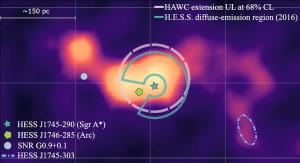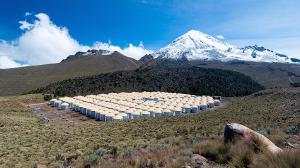Blog
Watching Like a HAWC
23 October 2024
 Albert, et al
Albert, et alNestled on the slopes of Cerro La Negra at an elevation of 13,000 feet is an unusual-looking observatory. Known as the High-Altitude Water Cherenkov (HAWC) observatory, it looks like a tightly packed collection of grain silos, which is essentially what it is. But rather than holding grain, the silos are each filled with 188,000 liters of water and four photomultiplier tubes. While it’s an unusual setup, it’s what you need to observe high-energy gamma rays from deep space.
Rather than observing the gamma rays directly, the observatory uses an effect known as Cherenkov radiation. Essentially, when a high-energy gamma ray strikes Earth’s atmosphere, it triggers the emission of a shower of particles moving at nearly light speed. They move so fast that they travel faster than light can move through water. So when these particles pass through a water silo, they emit Cherenkov radiation. HAWC is particularly sensitive to TeV gamma rays, which are the highest energy gamma rays produced in the cosmos. And with such a large number of detectors, HAWC can pinpoint the origin of these TeV gamma rays better than any other observatory, as a recent study shows.1
 Wikipedia user Jordanagoodman
Wikipedia user JordanagoodmanIt’s a bit rare for a high-energy gamma ray to strike Earth, so the team gathered seven years of observations, capturing 100 gamma ray events, each with an energy of more than 100 TeV. While that doesn’t sound like a lot, it is enough data for the team to determine their origin. The particles are coming from the center of our galaxy! Of course, many of you won’t be the least surprised. After all, there is a supermassive black hole in that area, so naturally it would produce high-energy particles. But this discovery helps us understand what’s going on.
In order for TeV gamma rays to reach us across 30,000 light years, our galactic black hole must produce even higher energy particles. Specifically, it must produce protons in the PeV energy range. Peta electron volts, which is a thousand times more energy than the gamma rays we see. These PeV protons then collide with interstellar gas molecules to produce gamma rays. This means there must be a mystery PeVatron source. We know that PeV protons can be produced in the most violent astrophysical phenomena, such as supernovae and black hole mergers, but these can’t explain what we observe.
To further understand the source, the team looks forward to the construction of the Southern Wide-field Gamma-ray Observatory (SWGO), which will be a facility similar to HAWC, but in the Atacama region of northern Chile. By combining observations from both, we should be able to localize the galactic source of PeV protons.
Albert, A., et al. “Observation of the Galactic Center PeVatron beyond 100 TeV with HAWC.” The Astrophysical Journal Letters 973.1 (2024): L34. ↩︎